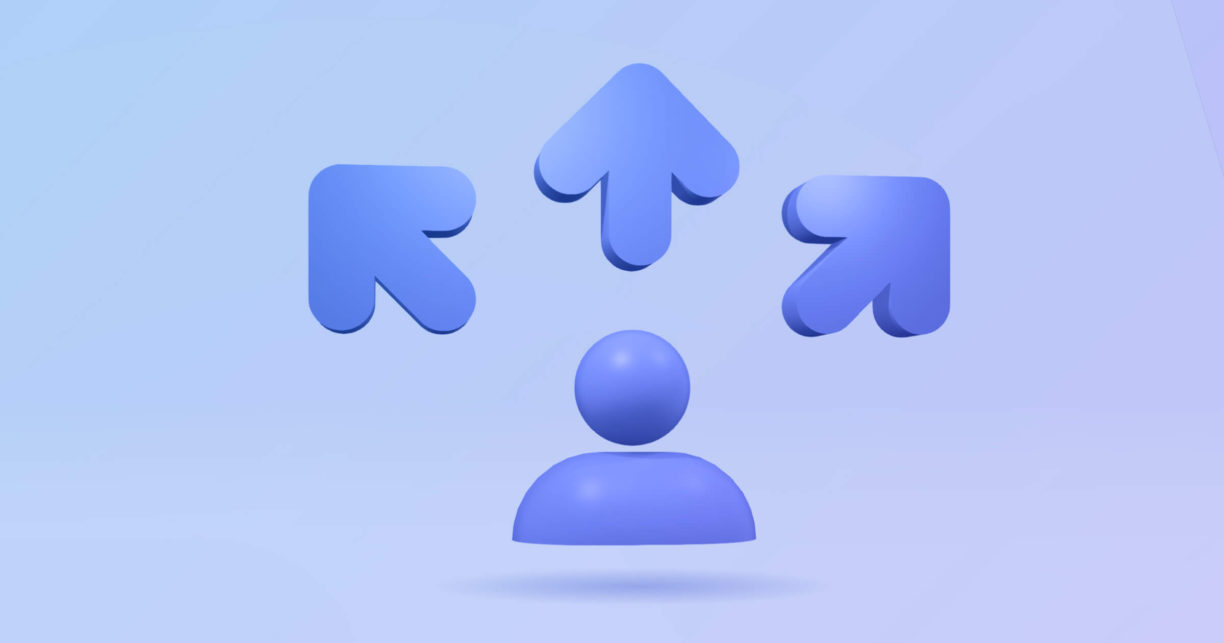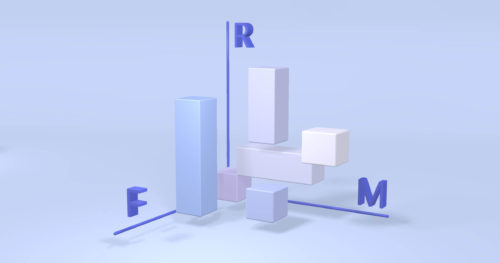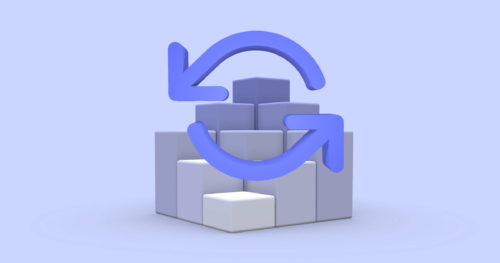Whether you believe it or not, your background, habits, and emotions play an integral role in your behavior.
Habits make most people do the same things every day. For instance, if you are a coffee drinker, it would be hard to resist the daily requirement of that morning ritual.
As a marketer, your task is to understand who your daily drinkers are and separate them from people who consume less regularly. Additionally, you must optimize the marketing campaigns to match your consumers’ behavioral patterns, pairing them with a specific message.
Nearly 74 percent of customers expect personalization on your website and feel frustrated when they are greeted by non-customized content. And this is where behavioral segmentation comes in—to ensure every shopper has a unique experience.
Below, let’s cover the basics of this kind of segmentation and ten examples of how marketers can use it to reach their business goals.

Reward customers with loyalty points every time they do what you want. Positive reinforcement can do magic!
What is Behavioral Segmentation?
A segment within behavioral marketing, behavioral segmentation explores groups, audiences, prospects, and customers based on their actions and behaviors. While psychographic segmentation and demographic studies who your customers are, behavioral segmentation looks at what they do.
It often works hand-in-hand with demographic, psychographic, and geographic segmentation to help build a complete customer profile. While other segmentation data suggest potential interactions between customers and your brand, behavioral data confirms it.
Generally, customer behavior can be grouped based on the interaction customers have with your brand, product, or services, such as:
Customer attitudes towards your brand and offerings
How customers use your offerings
Customers’ knowledge and awareness of it
How customers buy it
Customers are usually segmented based on their online behavior. For instance, how long do they spend browsing your website? Are they new or returning customers? How quickly do they exit your site? What do they add to their cart? And how frequently do they abandon their cart?
Thanks to the development of artificial intelligence (AI), effective, data-informed behavioral segmentation is now possible. Powerful AI marketing analysis platforms are currently helping marketers develop accurate and quick behavioral market segmentation. For instance, an all-in-one platform collects behavioral data, builds segment-based behavior graphics, and delivers tailored content reports for each consumer segment.W
Want to know more about the topic? Then check out or complete guide on behavioral segmentation in marketing!
10 Examples to Help You Grow Your Business
Perhaps, the most common ideologies associated with behavioral segmentation boil down to how users become customers (acquisition), how they use your website or app (customer journey), how frequently do they use your products or services (engagement), and how long they continue to use your product and services (retention).
1. Purchasing Behavior
If you wish to know more about your customers’ decision-making process, consider segmenting them based on their purchasing behavior.
Let’s take a ride-sharing app as an example. A working professional commutes to and from the office Monday through Friday. Whereas on weekends, they drive around in their own vehicle, so they don’t use the service. By understanding the behavior of this user, the ride-sharing service provider can target discounts on the weekends to encourage similar users to use the app on weekends.
Most companies leverage purchase, usage, and consumption tracking to forecast demand. However, segmenting customers based on their purchase behavior helps you understand when your marketing will be the most efficient as it enables you to understand the following:
What do customers consider before buying a product/service? Do they compare prices? Ask for recommendations? Read reviews?
The complex decision-making process. What factors influence customer decisions the most? Brand perception? A great deal? Or the time of the year?
The barriers to making a purchase are both obvious and non-obvious. Think, expense, need, etc.
The kind of behaviors that lead to a purchase
If we look deeper at the various purchasing behaviors, we can break them down into four broad categories.
2. Complex Buying Behavior
This happens when people plan to make an expensive purchase. They are completely immersed in the process and perform a lot of research. Homes, cars, and insurance policies are a few examples of offerings associated with a complex purchase decision.
Dissonance Reducing Buying Behavior
The buyer involvement in this category is also relatively high. Potential customers talk about the purchase with their friends and family and read many reviews. However, as the choices are fewer, the decision-making process is limited. For instance, if the customer is looking for an ergonomic chair, the key criteria will be the feature of the chair in question and the budget for it.
Habitual Buying Behavior
This involves people who buy stuff they use in their regular routine. Think of a loaf of bread or toothpaste. The involvement, in this case, is relatively low as people don’t necessarily notice a lot of differences between the brands they buy from.
Variety-Seeking Buying Behavior
Here, consumers have a lot of options when it comes to products, and the differences between various brands are pretty stark. People jump from one brand to another with limited involvement. Perhaps, it is because of a friend’s recommendation or after reading a handful of reviews online.
3. Occasion Purchasing
This component of behavioral segmentation takes timing as a factor that determines customers purchasing behavior. While some occasions are universal, like reserving a table in a restaurant on Valentine’s Day, others are personal. For instance, buying a monthly wine subscription box filled with luxe, hard-to-find flavors. Or life milestone purchases like a house or an engagement ring.
Occasion-based segmentation is often used by marketers, which refers to when people decide to buy. For example, if you look at some of the emails you receive, you will find coupons or flash sales emails sent to you on Fridays, which is when people are more likely to order on the weekends.
Starbucks is a classic example of how brands leverage occasion purchasing. Starbucks offers incentives to regular morning customers to bring them back in for another purchase later in the day. The brand uses email marketing and push notifications within its mobile app to offer happy hour events.
4. Benefits Sought
Another important factor differentiating customers under behavioral segmentation is the benefits they seek from an experience. Again, if we look at the Starbucks example, part of their customers prefers the convenience of ordering through the mobile app and having their beverage prepared and paid for when they come to pick it up. Nevertheless, their other customers are interested in ordering with a barista and enjoying the ambiance of a crowded coffee shop.
Another example that will help you better understand the concept is skincare. Consumers who buy skincare products have various reasons to do so.
Understanding the different benefits users seek from the experience with your product and service offers will help you better serve each segment with that experience. Here are a few segmentation examples for the various benefits customers might prefer:
Solution for oily skin
Removes dark circles
Price
Vegan or cruelty-free products
Mild fragrance
Non-irritating ingredients
Sephora has introduced a “Shop by Concern” category to determine the benefits and features shoppers value the most.
Something similar can also help your visitors find what they are looking for immediately while telling you about your shoppers’ concerns and the benefits they are after.
Customer Journey Stages
The customer journey refers to the process from when a customer becomes aware of your brand to the point when they make a purchase or recommend your brand to others. There are five touch points along the customer journey stages:
Awareness (Advertising, campaigns, PR)
Consideration (Blogs, email marketing, reviews, social ads)
Purchase (Store, website, contact center)
Retention (Community, rewards program, newsletters)
Advocacy (Social media, reviews, word of mouth)
Putting a finger on exactly where a shopper is in the customer journey can be challenging. However, segmenting customers based on where they are in their journey will reveal any pain points or reasons why a customer fails to take the desired action. For instance, if the stores frequently run out of stock, it highlights a problem with supply.
From your social media handles to your homepage, your customers engage with your brand and the content you produce at various stages across different channels. For this reason, it is imperative you leverage all customer data across multiple touchpoints and channels. This will help you customize messages based on their customer journey stage. For instance, you could offer your customers a discount on their next purchase in exchange for a survey or review as soon as they make a purchase.
5. Customer Loyalty
An important example of behavioral segmentation is customer loyalty. As a brand, you shouldn’t overlook the customers who exhibit loyal behavior to your business.
A popular method marketers leverage to spread loyalty among customers is establishing a rewards program. It can be as simple as a “buy 2, get the 3rd free” kind of mobile stamp card. Starbucks does the same and recently turned their loyalty program to offer rewards even faster.
In simple words, to retain users longer, and spread loyalty among app users, treat loyalty as royalty.
6. Usage Behavior
Usage behavior helps you filter out the most loyal customers. This parameter looks at the following:
How often do your existing customers use your products and services?
How are they using it?
What features do they use the most?
How much time do they spend using these features on average?
You can easily segment your customers based on how they use your product or service. The main usage segments are:
Heavy Users: These are your royal customers or your superfans. They remain highly engaged and spend a lot of time using your products and services, often making purchases.
Medium Users: These people purchase your products and services from time to time. Their relationship with your brand can be referred to as time-based or event-based. Think Cyber Monday, Black Friday, or Christmas.
Light Users: Though these customers engage with your brand, they rarely purchase your products or services.
By segmenting your customers, you can target the right marketing strategies for each and turn your light users into medium and heavy users. A few tested-and-proven approaches include offering giveaways, interactive content, and birthday treats like a free gift.
7. Customer Satisfaction
Do you accurately capture how satisfied your customers are at different stages of their customer journey?
If you don’t, you are making a terrible mistake. Only if you know how dissatisfied your customers are will you be able to jump right in and fix potential problems or address any concerns. Additionally, you can target highly-satisfied customers with cross-sells, up-sells, or loyalty programs.
Let’s take a look at how behavior segmentation on customer satisfaction can look like:
High Satisfaction Segment
Target them with up-sells, or cross-sell opportunities
Offer them loyalty programs
Reach out to them regarding references or case studies
Analyze the customers in this segment to figure out patterns that can potentially lead to high satisfaction
Low Satisfaction Segment
Restrain from up-selling, cross-selling, and other promotional offers
Target them using retention campaigns
Consider personally reaching out to them from the customer service or success team
Study customers in this segment to figure out the root cause of low satisfaction
8. Interest
You don’t have to be a huge player like Netflix or Spotify to tap into the potential of smart recommendations based on your customers’ interests.
In fact, all brands should consider capitalizing on relevant and personalized content, product, or service recommendations. Segmenting your customers in this way is an excellent way to drive engagement, as people only see what’s most relevant to them.
9. Engagement Level
Engagement is a valuable metric both in the pre-purchase and post-purchase parts of the customer journey. For instance, you can leverage engagement-based segmentation to observe how connected different prospects are in your pre-purchase funnel. Additionally, you can discover how interested people are after their initial purchases by analyzing their repeat visits, purchases, or engagement with your content.
10. Brand Interactions
This aspect involves studying how customers engage across all your brand channels, both online and offline. It also tells you how much a customer is engaged with your brand. Think of Disney, a brand covering everything from movies, dedicated stores, parks, merchandising, and vacations.
The various types of interactions include:
Frequency of website visits
Frequency of store visits
Web pages visited
Content viewed on social media
Interactions with your social media
Frequency of purchase
Previous purchases
6 Quick Tips to Segment Users by Behavior
Here are a few ways to efficiently implement behavioral segmentation in your marketing campaigns:
Consider remarketing campaigns based on past user behavior.
Send targeted content to user segments based on their interests, frequency of app usage, average order value, and more.
Schedule your messaging campaigns around when users are the most active and likely to respond favorably.
Focus your marketing resources on users who show signs that they are ready to convert.
Personalize messaging and delivery times based on a user’s location, local events, native language, and time zones.
Target potential high-value users by understanding who your user base is and how they use your app.
Behavioral Segmentation Variables
If you just performed an audience analysis, you already have the infrastructure for your behavioral segmentation laid out. So, your next task is to choose the touchpoints from where you plan to gather data—this includes all channels that connect your brand to your audience. Then start figuring out the scope of each segment.
Different metrics represent different segmentation strategies. Meaning, the data you monitor using your web analytics tools will depend on the type of behavioral segmentation and the goals you plan to achieve.
Generally, you will be adding data from your affiliates or partners. And this will often lead to getting an entirely new set of behavior in the audience coming from specific partners or partner sites.
It might also be beneficial to gather data from other sources, like CRM, social media, and your email automation tool. In certain industries, you should also consider adding non-digital touch points to the lot.
Segmenting Users Based On Behaviors For More Targeted Strategies
Now think that the marketing department feels all of this is a waste of time and resources because the generic marketing material is either too complex for light users or boring for heavy users. And you have chosen to go with user status segmentation for your SaaS application that focuses on business owners.
In such a scenario, the easiest way to segment your users is by leveraging a binary system where you set a specific condition on a particular metric. You can divide the audience into groups based on the frequency of visits. For instance, do they visit more or less frequently than once a day?
You could also use the time they spent on your website as a gauge. For instance, visitors who spend more than an hour on your site every day can be considered heavy users.
Now, if you are up for a more complex method, you could choose to combine metrics and scale. So, instead of looking at time spent on your site, you will consider audience loyalty.
With that being said, your main task is to determine what to measure.
Monitoring Your Segments
This kind of segmentation isn’t something you set and forget. Once you have your segmentation strategy in place, you have to start coming up with specific content to target each group. Hence, it is important to monitor the performance and behavior of your segments constantly.
Here are a few key metrics worth monitoring for each segment:
Average Order Value
Time of Purchases
Last Time of Purchase
Frequency of Abandoned Carts
You can use these insights gained to particularly double down on marketing to high-spending segments, alongside identifying the segments that aren’t engaging and altering your marketing.
Furthermore, you can compare metrics for the segments against the metrics for the entire database to understand whether behavioral segmentation is offering better results than the average.
Conclusion
The days of non-customized marketing campaigns are long gone. Currently, people are specific about why they buy a product or service. Hence, it is up to you to efficiently target your customers using demographic, geographic, psychographic, and behavioral segmentation.
While this type of segmentation was an imprecise process earlier due to the lack of robust data gathering analytics. However, machine learning (ML) and artificial intelligence (AI) these days allow organizations to get real-time insights that power their segmentation efforts.
Additionally, with everything turning digital, it is easier for marketers to track what users are doing online, thereby generating a wealth of marketing data. In other words, AI and ML allow you to personalize your segmentation strategies.
In this article, you saw the ten behavioral segmentation examples demonstrating how to use this advanced technique to ace the marketing segmentation game. We have also given you a few tips and tricks to strengthen every customer journey stage. Now, all that’s left to do is build these examples into your strategy and let the magic work.
Connect your e-shop with Verfacto behavioral data and start seeing the full picture of your visitors.
FAQs
Why is Behavioral Segmentation Important?
Behavioral segmentation is very important for eCommerce businesses because it’s accurate and helps you to get better ROI and lower your customer acquisition costs. Here are a few reasons why you should use it on your marketing strategy:
Enhanced Targeting Accuracy: By getting a better idea of different behaviors, you will be able to direct your marketing messages more efficiently. For example, introductory offers will appeal to newer customers, whereas long-standing loyal customers will be more attracted to loyalty programs like an invitation to join an exclusive club.
More Personalized Experiences: The same generic messages you send to your email marketing list don’t work these days. By identifying your audience’s needs, wants, concerns, and the type of messages they notice, make relevant offers and suggestions for each one personally, and they will be more likely to take the desired action.
Find High Customer Engagement: By filtering the most engaged customers from the uninterested, you can target your products and services to people who really want them the most.
Cost-Effectiveness: Along the same lines as the previous point, by figuring out your most interested customers, you can target your budget at your most valuable audiences instead of wasting it on cold leads.
Trackable: You get to track metrics within each segment, take action, and improve the results.
Increase Brand Loyalty: Only when you make your customer feel special will they stick with your brand longer. Customer loyalty increases customer lifetime value, thereby boosting the revenue for your business.




